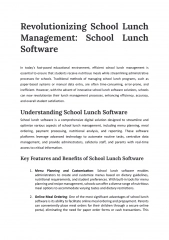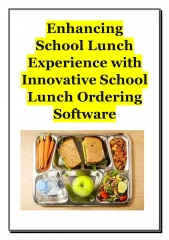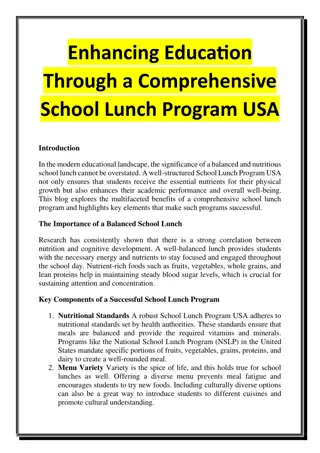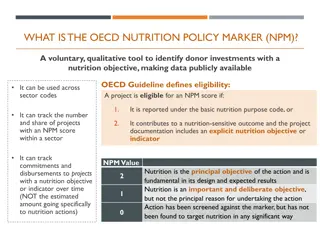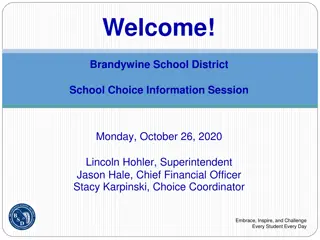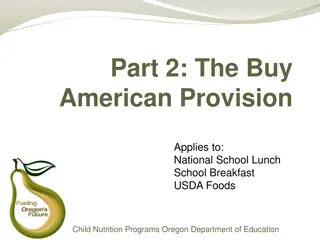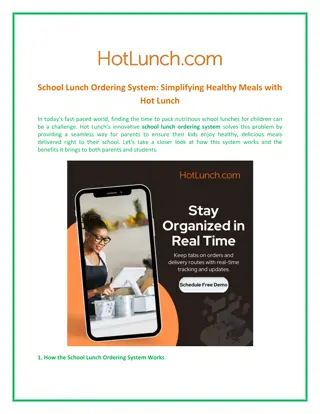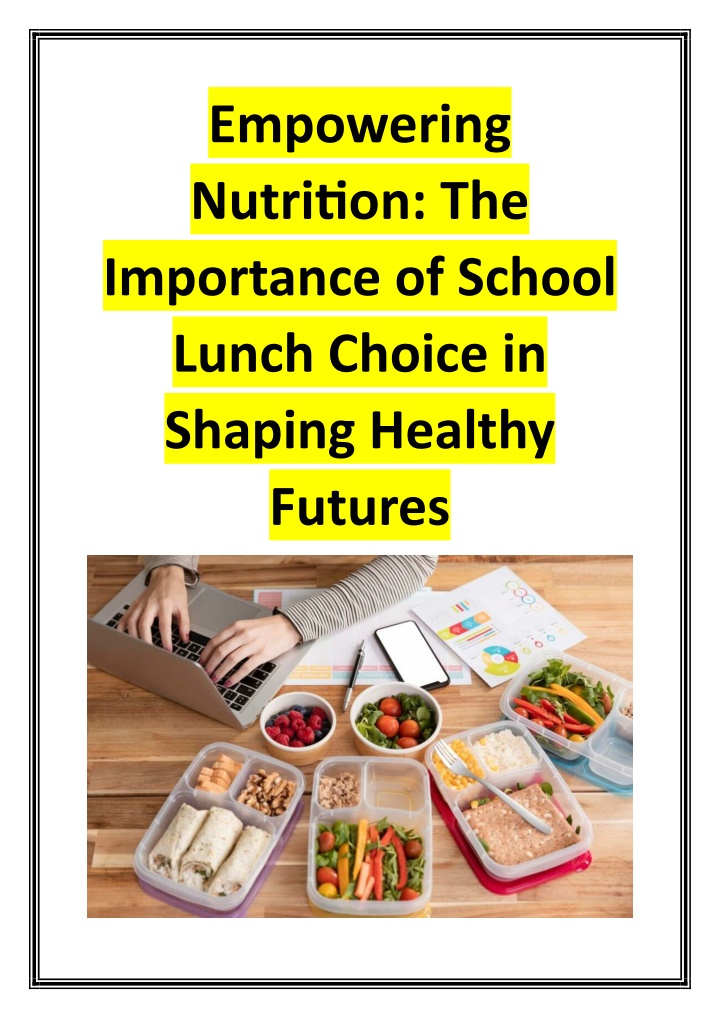
Empowering Nutrition - The Importance of School Lunch Choice in Shaping Healthy Futures
In todayu2019s educational landscape, the importance of school lunch goes far beyond simply filling a studentu2019s stomach. Itu2019s a gateway to better health, improved concentration, and even increased academic performance. Among the many strat
Uploaded on | 1 Views
Download Presentation

Please find below an Image/Link to download the presentation.
The content on the website is provided AS IS for your information and personal use only. It may not be sold, licensed, or shared on other websites without obtaining consent from the author. If you encounter any issues during the download, it is possible that the publisher has removed the file from their server.
You are allowed to download the files provided on this website for personal or commercial use, subject to the condition that they are used lawfully. All files are the property of their respective owners.
The content on the website is provided AS IS for your information and personal use only. It may not be sold, licensed, or shared on other websites without obtaining consent from the author.
E N D
Presentation Transcript
Empowering Nutrition: The Importance of School Lunch Choice in Shaping Healthy Futures
In todays educational landscape, the importance of school lunch goes far beyond simply filling a student s stomach. It s a gateway to better health, improved concentration, and even increased academic performance. Among the many strategies for improving school meal programs, School Lunch Choice has emerged as a powerful tool in creating more personalized and positive mealtime experiences for students. By giving children the ability to choose their meals, schools promote autonomy, respect dietary needs, reduce food waste, and encourage healthy eating habits. Let s explore how offering school lunch choice can transform cafeterias into more inclusive, engaging, and nutritionally balanced environments. What Does School Lunch Choice Mean? School Lunch Choice refers to the practice of providing students with options in their daily school meals. Rather than serving a single standard meal to every student, schools offer multiple dishes or meal components, allowing students to choose based on their preferences, dietary restrictions, or cultural needs. This might mean selecting between vegetarian and non-vegetarian meals, different sides, or even build-your-own meal formats. The goal is to increase student satisfaction, improve nutritional intake, and reduce uneaten food. Why School Lunch Choice Matters 1.Promotes Autonomy and Decision-Making Skills Allowing students to make food choices helps them feel more in control and teaches responsibility. Even at a young age, making decisions about what they eat contributes to confidence and independence. 2.Improves Nutritional Outcomes When students can choose foods they enjoy, they are more likely to eat and less likely to throw food away. This results in better nourishment and encourages them to develop lifelong healthy eating habits.
3.Reduces Food Waste Food waste is a significant problem in schools with fixed meal systems. With a choice-based model, students are more likely to select meals they plan to eat, significantly reducing leftovers and discarded food. 4.Cater to Dietary Restrictions Today s student population is diverse, with various dietary needs such as allergies, religious dietary laws, or ethical food choices. Offering variety ensures inclusivity and safety. 5.Encourages Culinary Education When students are given multiple food choices, they are introduced to different cuisines and ingredients. This increases food literacy and appreciation for diverse diets. How Schools Can Implement School Lunch Choice 1.Start Small with Simple Options Not every school can overhaul its kitchen overnight. Start by offering two entr e options or a rotating selection of fruits and vegetables. Even small changes can make a big difference. 2.Use Technology for Menu Selection Digital school lunch ordering systems allow students and parents to pre-select meals. This ensures accurate preparation and saves time during lunch breaks. 3.Survey Student Preferences Gathering feedback through surveys helps tailor the menu to student tastes and demands. When students feel heard, participation in lunch programs often increases. 4.Offer Build-Your-Own Stations Just like popular fast-casual restaurants, schools can offer stations where students customize their meals tacos, sandwiches, salads, etc. This empowers students while keeping nutrition in check. 5.Collaborate with Dietitians
Ensure that all available meal choices meet the nutritional standards required for school-aged children. Working with nutritionists ensures both variety and health. Challenges in Providing School Lunch Choice While offering choices brings many benefits, it also comes with its own set of challenges: Cost and Resource Allocation:More choices can mean higher food and labor costs, which may strain school budgets. Kitchen Capabilities:Smaller or older school kitchens might lack the infrastructure to prepare multiple meals simultaneously. Maintaining Nutritional Standards:More options mean more planning to ensure that each meets the nutritional requirements set by authorities. Equity Issues:Ensuring all students, regardless of socioeconomic status, have equal access to all food choices is crucial. However, with strategic planning, these challenges can be overcome. The Role of Parents and Community Parents play a vital role in shaping children s food choices. Schools can involve parents in the planning process by: Sending home menus in advance Requesting feedback or suggestions Organizing taste-test events with students and parents Offering education about nutrition and balanced diets Additionally, partnerships with local farms or community organizations can help source ingredients, promote sustainability, and enrich food education programs.
Case Study: A Schools Success with Lunch Choice Take the example of a public school district in California that implemented a student-driven lunch program. Prior to the change, the school served a single daily meal option, resulting in nearly 35% food waste and declining participation. After offering three daily entrees (including vegetarian and allergy-friendly options) and rotating fruit and vegetable choices, participation jumped by 25% and food waste dropped by 40%. The program also introduced themed meal days, further boosting student enthusiasm. Benefits of School Lunch Choice for Schools 1.Higher Participation in Meal ProgramsWhen students enjoy the food, they are more likely to eat school-provided meals, boosting program revenue. 2.Positive School CultureWhen food options reflect student voices and needs, it builds a sense of respect and inclusion within the school. 3.Better Learning OutcomesWell-fed students perform better academically and behaviorally. A lunch program that appeals to students ensures they are ready to learn after lunch. Future of School Lunch Programs As technology advances and student diversity increases, schools will need to continue evolving their meal programs. The future of school lunch includes: AI-driven meal suggestions based on student feedback Integration of sustainability practices like composting and local sourcing Enhanced tracking of individual student nutrition and preferences Continued digitization of ordering, payments, and feedback systems
Conclusion School Lunch Choiceis more than a trend it s a movement toward creating healthier, more inclusive, and engaging educational environments. By offering students the ability to choose meals that suit their tastes and needs, schools empower children to make smart decisions, embrace diversity, and develop lifelong habits that promote health and well-being. Whether you re a parent, educator, or policymaker, supporting school lunch choice is a meaningful step toward nurturing the next generation one meal at a time.

